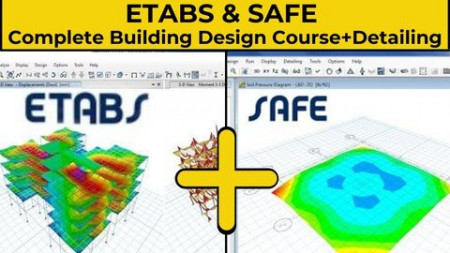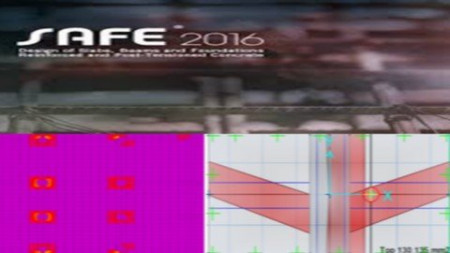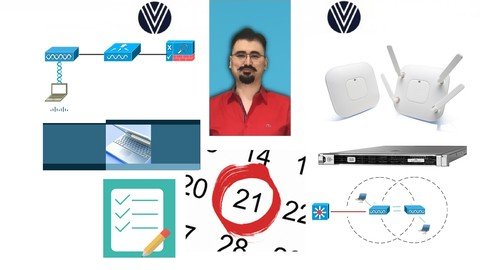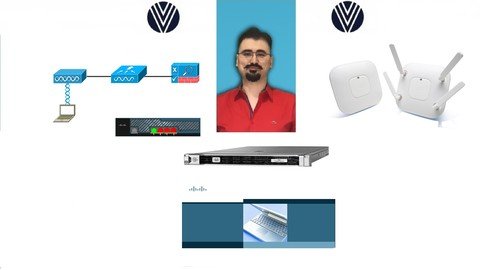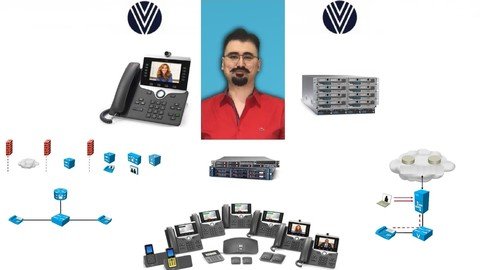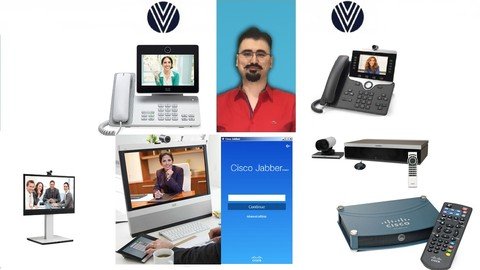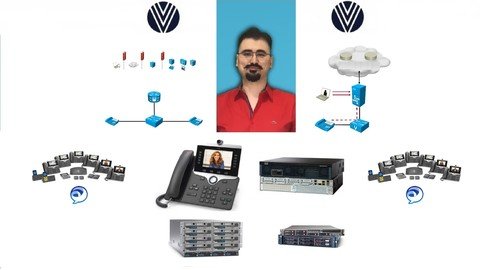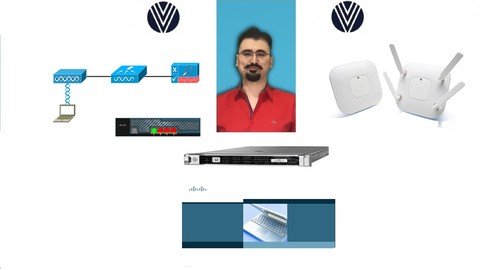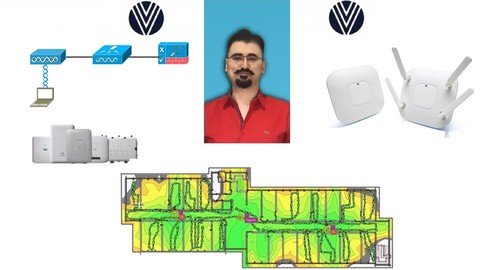Cisco Wireless Fundamentals With WLC For CCNA 200-301 CWNA
MP4 | Video: h264, 1280x720 | Audio: AAC, 44.1 KHz
Language: English | Size: 1.95 GB | Duration: 5h 48m
The Only Course You Need To Learn Cisco Wireless Fundamentals Theory WLC Labs For New CCNA 200-301 and New CWNA CWNA-108
What you'll learn
-You will be ready for your CCNA 200-301 Exam in Wireless part in 21 Days
-You will get better at your job which involves Cisco Wireless devices.
-You will be able to analyze and troubleshoot problems with your Cisco Wireless devices.
-You will have great understanding for your daily profession.
-You will learn how to implement certain topics on Cisco Wireless Lan Controller.
Requirements
Some basic networking experience.
Description
Welcome to The Course "Cisco Wireless Fundamentals With WLC For New CCNA 200-301 The Complete Course in 21 Days Theory Labs "
With the help of this course, you will be able to get all necessary information to learn your Cisco Wireless Fundamentals With WLC For For New CCNA 200-301 and CWNA-108 in only 21 Days
You will learn theory behind each topic and then see how they are configured on real devices. In the end, you will be able to test yourself before The BIG DAY.
Welcome to Cisco Wireless Fundamentals With WLC For For New CCNA 200-301 and CWNA-108.
In this course you will learn ccna wireless exam topics and important and useful subjects for your profession.
Lets go over each chapter and go on more detail about what to come in this course,
First off, you will learn a great deal about rf fundamentals.
This is the starting point for your wireless journey and it will lay a good foundation for the following chapters
In the first chapter we will be describing the propagation of radio waves, we will learn about rf signals and the spectrum.
We will answer some questions like: What is frequency, what is wavelength, what is amplitude and what is phase difference.
We will also learn about different phenomenas related with rf signals such as absorption, reflection, diffraction, scattering, refraction, multipath and fading.
We will also learn free space path loss and also fresnel zone.
On the second part of this chapter, we will go deep into rf fundamentals, what is signal strength, what does RSSI mean, how to calculate transmit power.
We will go over some different interference types and the noise, what are different device requirements and capabilities.
We will also learn principles of rf mathematics, how to calculate dB, dBi, dBd, dBm and how we can measure different power levels.
We will also learn to calculate EIRP. We will see wifi antenna characteristics, how does the radiation pattern of an antenna occur, what is polarization,
how gain is measured, what is the beamwidth of an antenna and we will go over different types of antennas: Omnidirectional, yagi,patch and dish
We will explain different antenna connectors and why we need them and lastly, we will study amplifiers and attenuators
On our second chapter, we will learn about 802.11 Technology Fundamentals
In this chapter we will describe basic Wi-fi governance, what are the governing regulatory bodies, what is IEEE, why do we need to learn about ieee 802.11 and what is wifi-alliance.
On the second part of this chapter, we will also learn about usable channel and power combinations. We already learned about EIRP, we will also learn its limitations. We will be learning about ISM and UNII frequency bands. We will go over rrm fundamentals on the last part of this chapter
We will also learn about 802.11 fundamentals, what is modulation, what is channel width, how do we use them. We will learn about MIMO multiple input multiple output, we will go over wireless topologies and we will learn different wireless frame types such as management, control and data. So simply we will learn a lot about 802.11 fundamentals in this chapter
In Chapter 3 we will learn about various Cisco wireless architectures.
We will learn why we need autonomous, cloud architecures, why do we need split mac architecture and we will learn differences regarding centralized flex connect and converged deployment types, then we will go over physical connections for wired and wireless infrastructure. We will understand how to connect wlcs to switches how to connect different ap types to switches and why do we need etherchannel and also learn what do wcms on switches add us in terms of benefits.
Then we will examine wlc and ap management access connections, what are different management methods, what are wlc ports, what the different wlc interfaces do and we will also learn why we should disable management via wireless.
Capter four is about operating a wireless network.
In this chapter we will talk about how to execute initial setup procedures for various cisco wireless infrastructures, how to do initial setup for autonomous access points, how to setup cloud aps and manage them. We will learn how to setup centralized wlcs and wireless control modules. Next up, we will learn ap boot process and different capwap discovery methods, then we will understand what are different capwap join processes
and we will learn how access points choose to join a specific wlc. What is the master controller, why do we need primary secondary and tertiary controllers
W wil also compare different access point modes, such as monitoring mode flex connect mode and wips
O the second part of this chapter we will configure a simple wlan, what do we need to configure, what are the parameters that need to be configured
what do we need to configure for security, whether we should broadcast the ssid or not, different security levels for layer 2 and layer 3 security and how to choose a aaa server and some parameters for advanced topics.We will also go over different platforms for wireless management and configurations, how we can configure a wireless lan controller via gui and cli, how we can configure wireless lan controllers and autonomous access points via cisco prime infrastructure, how we can use ise identity services engine as a aaa server for wireless configurations.
Inthe last part we will talk about how to maintain a wireless network, how to get wireless lan controller backups, how to do code updates for wireless components such as autonomous access points, aireos based controllers and ios xe based controllers.
Chapter five is all about client connectivity configuration, In this chapter we will learn how to configure your clients and how to configure your wlans to prepare for client connectivity. In this chapter we will talk about authentication and encryption, what is authentication, what are different types of encryption some examples of it, tkip aes.
Then we will go over 802.1x and eap, we will understand the eap process and then we will compare most common methods, peap, eap-fast eap-tls and we will go over aaa server options and then we will talk about different client authentication methods, why do we use open authentication, what are benefits and what are disadvantages of open authentication. We will also talk about psk authentication and local eap, then we will learn how to configure them in your wlc. We will go over wireless authentication using ISE a radius server, we will also learn how to configure web authentication on your wlc and we will also talk about different wpa modes: wpa personal wpa enterprise wpa2 personal and wpa2 enterprise, all those different modes will be discussed in detail.
And on the second part of chapter five
we will learn how to provide client connectivity in different operating systems, we will go over how to configure windows ios macos and android devices
and then we will talk about roaming.
We will learn different components of mobility architecture such as mobility controller and mobility agent, we will go over different types of roaming, intracontroller roaming and intercontroller roaming. We will also talk about main deployment types centralized mobility and converged mobility
for both layer 2 and layer 3 roaming and then we will go over how to configure wireless guest networking with anchor controller and foreign controller
Then we will begin chapter six, in this chapter, we will learn how to troubleshoot wireless networks. We will go over different wlan configuration settings that we need to check. What can go wrong for access point settings, and also we will talk about which settings we need to check on client side. Then we will learn some Cisco tools to troubleshoot our controllers and also we will learn some of third party troubleshooting tools such as spectrum analyzers, wifi scanners and packet analyzers and we will go over a couple of examples for these tools.
As the last chapter we will learn about site survey.
In this chapter we will be talking about different site survey methods, one of them is offsite site survey which is also known as predictive site survey
The other method is onsite and on onsite site survey we have couple of options. One is predeployment site survey, we can use ap on a stick as an active predeployment onsite site survey. We will also learn the postdeployment site survey and in the post deployment we can have passive and active site survey options. We will also go over the reasons why we need site survey and how we can apply outcomes of those site surveys to get our wireless design better
and we will also talk about what we need for our client application requirements, what are real time applications what are non real time applications and
how we can implement those requirements properly.
Thank you for joining me on this journey
I hope you will love to learn with us
Who this course is for
So you want to achieve your CCNA 200-301 Exam for Wireless Fundamentals before the deadline, this is what you need.
I designed this course for you, the one with some or none CCNA 200-301 Exam Wireless knowledge and a great deal of curiosity for the wireless world. You may also be the one who operates wireless devices but you want to know more to get better at your job in configuring, installing, operating and troubleshooting Cisco Wireless devices.
Screenshots
